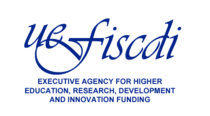Welcome to MetaFLEN website!
Plamonic and dielectric metasurfaces as platforms for fluorescence enhancement
Demonstration experimental project
Project duration: 10.08.2020- 10.08.2022
Project budget: 600.000 RON
Main domain: Eco-nano-technologies and advanced materials

Results 2021 [...]
Results 2022
Three experimental models of metasurfaces were developed and validated:
- with quasi-periodic elements obtained by lithography with polystyrene nanospheres;
- with periodic elements obtained by electron beam lithography (EBL);
- with random elements obtained by hat treatment of a continuous metal layer.
The developed plasmonic or dielectric metasurface platforms offer the possibility of fluorescence enhancement with enhancement factors between 1.17 and 423, depending on the geometry of the meta-atoms, the materials used and the type of fluorophore.
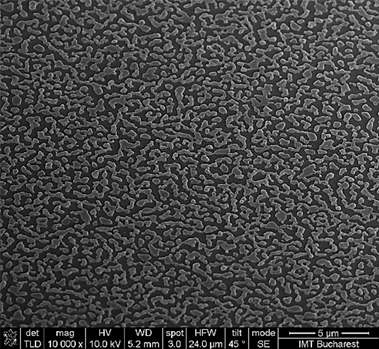 |
SEM micrograph of the third experimental model |
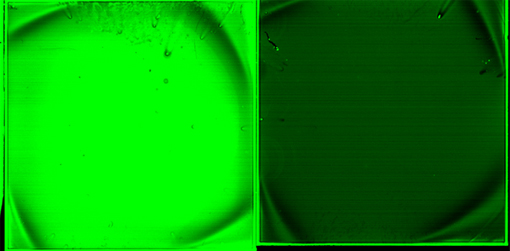 |
Fluorescence improvement of up to 423-fold with the third experimental model |
Functionalization methods were optimized to facilitate the attachment of thio-oligonucleotides on the metasurfaces platforms with randomly distributed elements which were identified as the optimal structures for bio-detection.
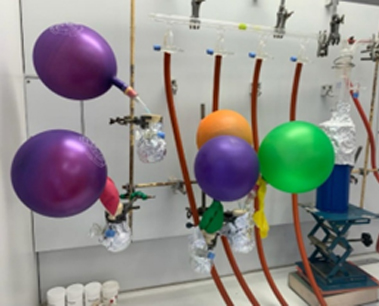 |
Image with a step from the functionalization process: immersion in dithiothreitol solution (important in breaking the disulfide bridges that tend to form involuntarily between thio-oligonucleotides) under argon |
The optimums metals for bio-applications are gold and silver. Thus, samples experimentally obtained by depositions of: i) 4 nm Au (equivalent mass) on both silicon and glass substrates (6a sample); ii) 15 (5a sample) and 30 nm (7a sample) Ag layers, configured by heat treatment on both silicon and glass substrates.
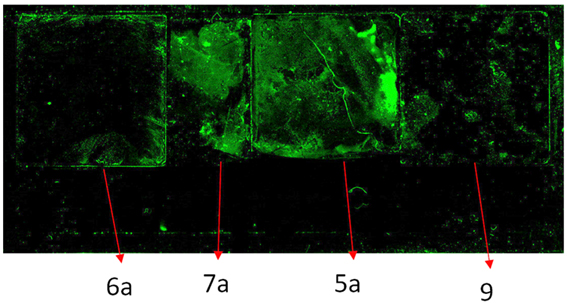 |
Fluorescence intensity of thio-oligonucleotides labelled with FAM on top of metasurface structures |
Results, December 2021
1. Extensive numerical analysis performed by three-dimensional (3D) simulations using the finite difference in time and space (FDTD) method to identify the optimal geometry, size and configuration of the nano-structures that constitute a plasmonic metasurface, focusing on achieving the highest resonance at various wavelengths (NIR-VIS), for local enhancement of the excitation field and collection efficiency of emitted photons. Three district configurations were investigated at 532 nm wavelengths excitation wavelength for Rhodamine 6G) and 552 nm (emission wavelength) respectively. The results offer localized electromagnetic filed enhancement of up to 6.25 folds.
 |
The elementary cell through which can be obtained a silver metasurfaces with: a) nano-disks; |
 |
Electromagnetic field intensity for silver nanostructures |
2. Fabrication of plasmonic metasurfaces with random or controlled distribution and characterizations using SEM or AFM techniques. The metasurfaces with random distribution were obtained by thermal annealing a 15 nm Ag layer.
 |
 |
 |
| SEM - structures obtained in O2 atmosphere |
SEM - structures obtained in N2 atmosphere |
AFM - structures obtained in O2 atmosphere |
The metasurfaces with controlled distribution were obtained whit electron beam lithography and lift-off method.
 |
| SEM micrographs |
3. Fluorescence enhancement for Rhodamine 6G tests on fabricated structures. The tests were performed on 2 types of substrates (glass and silicon) using 3 distinct concentrations (50/10/5 µM) of dye dispersed in PMMA.
 |
 |
| Florescence intensity |
 |
Florescence intensity on bare silicon (without metasurface), on random metasurface (R6G without PMMA) and with R6G dispersed in PMMA (metasurface + R6G in PMMA).
 |
| Fluorescence scan on areas with Silver/Aluminium controlled metasurfaces |
The final scope of this activity was to obtain metasurfaces able to attach organic compounds to use as diagnostic tools in different medical devices. The DDS Diagnostic team functionalized the metasurfaces obtained by IMT and chemical bound on them biomolecules labelled with different fluorophores. The chemical functionalization was achieved on the glass, silicon, silver and gold surfaces using different methods. For example, gold surfaces were covered with alkanethiols and the carboxyl groups of them were activated with the EDC/NHS system in order to bind amino groups from the biomolecules. The fluoresces data proved the binding of the biomolecules on the metasurfaces, their stability in terms of temperature and time and the ability of the metasufaces to enhance the fluorescence of the fluorophores bound on the biomolecules.
 |
| Fluorescence scan on areas with Silver/Aluminium controlled metasurfaces |
News
„Most original contributions of young scientists” 4th Autumn School on Physics of Advanced Materials (PAMS-4) Sant Feliu de Guixols, Costa Brava, Spain, 2021 pentru lucrarea “Metasurface for sensing applications”, autori: R. Tomescu, V. Anastasoaie, C. Parvulescu, L. Mihai, C. Paun, D. Cristea

